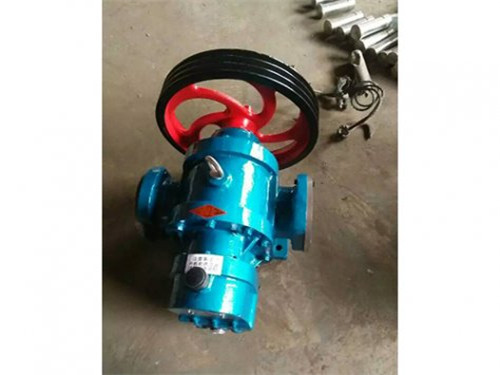Gear oil pump series
High viscosity pump series
Centrifugal pump series
Pump series for other purposes

LC high viscosity Roots pump
The LC high viscosity Roots pump is a modified version of the LC pump that solves the problem of transporting asphalt and condensate. An insulation layer is added to the outer surface or end cover of the pump casing, and steam or thermal oil circulation is used to insulate the pump chamber.
Working principle:
The working principle of LC high viscosity Roots pump is similar to that of Roots blower. Due to the continuous rotation of the rotor, the extracted gas is sucked into the space v0 between the rotor and the pump casing from the inlet, and then discharged through the exhaust port. Due to the fact that the v0 space is completely enclosed after inhalation, the gas inside the pump chamber is not compressed or expanded.
The LC high viscosity Roots pump is located in the pump chamber, with two "8" shaped rotors installed perpendicular to each other on a pair of parallel shafts, which are synchronously rotated in opposite directions by a pair of gear belts with a transmission ratio of 1. Maintaining some clearance between the rotors and the inner wall of the pump casing can achieve high-speed operation. Due to the fact that Roots pump is a vacuum pump without internal compression, the compression ratio is usually very low, so high and medium vacuum pumps require a front stage pump. The vacuum of a Roots pump depends not only on the structure and manufacturing accuracy of the pump itself, but also on the vacuum of the preceding pump. In order to improve the vacuum degree of the pump, the Roots pump can be used in series.
But when the top of the rotor rotates past the edge of the exhaust port and the v0 space is connected to the exhaust side, due to the high gas pressure on the exhaust side, a portion of the gas rushes back into the v0 space, causing a sudden increase in gas pressure. When the rotor continues to rotate, the gas is discharged from the pump.
The LC high viscosity Roots pump produced by our factory comes in two forms: belt drive and gear reducer drive. This pump has the characteristics of low speed, small volume, large flow rate, low power consumption, self suction, no need for oil introduction, and convenient use. It can be widely used for transporting petroleum and petroleum products (gasoline replaceable copper pump blades) and for transporting various oils and liquids in factories. Such as crude oil, paint, lubricating oil, glass glue, oleic acid, toothpaste, and light alkaline (soap processing) liquids; Food processing can transport various liquids, such as soybean milk, yeast, syrup, etc. Loading and unloading various oil tankers and tankers, convenient to use, and capable of working in both forward and reverse directions.
Notes on the operation of LC high viscosity Roots pump
1、 Before installing the new pump, please carefully read the instruction manual. If there is no instruction when ordering, the inlet direction of the pump is left in and right out. The pump has been specified at the factory, please be careful not to install it incorrectly. Install soft connections at the inlet and outlet of the pump to prevent pipeline/reactor sinking from affecting pump operation. Prevent the pump flange from being pulled apart by the pipeline.
2、 When installing the LC high viscosity Roots pump in the new pipeline, it is necessary to strictly check that there is no welding slag in the pipeline. After the pipeline is blown clean and there is no welding slag, it can be installed. It is better to install a disposable filter screen (60-80 mesh) at the inlet of the pump to prevent welding slag from entering the pump chamber. After debugging, check if there is welding slag at the filter screen of the pipeline. If there is welding slag, please clean it up. No welding slag can be removed from the filter screen. If welding slag enters the pump chamber, remove the back cover of the pump, remove the welding slag, clean it up, and then install the back cover.
3、 The inlet pipeline elbow of LC high viscosity Roots pump should not be too many (more than 2). If there are too many bends in the inlet pipeline, it will seriously affect the suction head of the pump. That is to say, the cavitation margin of the pump cannot be exceeded. If the inlet suction pipe of the pump is too long or there are too many bends, the pump suction head will decrease. There may be phenomena such as pump failure to discharge and insufficient pressure.
4、 When debugging a high viscosity pump,
(1) Pay attention to adding 70 industrial gear oil to the gearbox, and do not exceed the oil mark. Too much oil is added to the gearbox, and as the machine runs, the temperature inside the gearbox increases, causing a vacuum phenomenon and oil to leak out.
(2) Remove the fan cover of the motor, and then manually turn the motor fan blades 360 degrees 5-6 revolutions without any jamming points. Confirm that the concentricity of the motor, pump, and reducer is consistent, and adjust the concentricity of the pump and motor if they are not concentric.
5、 Debugging of pump steering. Attention: When confirming the direction of the pump, please manually tap the control switch of the power supply 1-2 times to see if the direction of rotation is consistent with the arrow on the pump label. Inconsistent, please correct the power supply wiring method.
6、 After the above inspection is completed, first open the inlet valve and outlet valve of the pump. If there is a bypass at the pump outlet, please close all the bypasses. Start the pump after the material enters the pump. Attention! Do not start the pump before the inlet and outlet valves are opened, as this may cause the pump to hold pressure. Seriously causing the pump body to rupture. The consequences are at one's own risk.
7、 Start the pump, press the power control switch 1-2 times, and start it directly after seeing that the pump rotates normally.
8、 The pump is running normally and debugging is completed.
Technical parameter table for LC high viscosity Roots pump:
| model | flow m3/h | working pressure mpa | Entrance and exit caliber mm | Allow suction height m | Transmission form | Power allocation | power KW | Pump efficiency % | Select number r/min | Medium temperature ≤°C | weight kg | Application scope | |||||
| Reducer model | Triangle code | electrical machinerymodel | |||||||||||||||
| LC-10/0.6 | 10 | 0.6 | 40 | 6 | ZD14 | A1778 |
| 3.0 | 62 | 400 | 140 | 167 | Diesel, engine oil, glycerin, petroleum, toothpaste, edible oil, heavy oil, etc | ||||
| LC-18/0.6 | 18 | 0.6 | 50 | 6 | ZD14 | A1778 |
| 5.5 | 62 | 400 | 140 | ||||||
| 4.0 | 62 | 140 | 219 | |||||||||||||
| LC-38/0.6 | 38 | 0.6 | 65 | 6 | ZD14 | B2350 |
| 7.5 | 65 | 400 | 140 | 269 | |||||
| LC-50/0.6 | 50 | 0.6 | 100 | 6 | ZL200 |
| 15 | 70 | 445 | 140 | 1160 | ||||||
| LC-80/0.6 | 80 | 0.6 | 200 | 6 | ZL200 |
| 30 | 70 | 209 | 140140 | |||||||
| LCQT-100/0.6 | 100 | 0.6 | 200 | 6 | ZL23.1 |
| 37 | 73 | 254 | 140 | |||||||
| LCQT-10/0.6 | 10 | 0.6 | 40 | 6 | ZD14 | B2350 |
| 3.0 | 62 | 400 | 140 | 167 | Gas oil, solvent oil, kerosene, etc | ||||
| LCQT-18/0.6 | 18 | 0.6 | 50 | 6 | ZD14 | A1778 |
| 5.5 | 60 | 400 | 140 | 219 | |||||
| 4.0 | 62 | 140 | ||||||||||||||
| LCQT-38/0.6 | 38 | 0.6 | 65 | 6 | ZD14 | A1778 |
| 7.5 | 65 | 400 | 140 | 269 | |||||
| LCQT-50/0.6 | 50 | 0.6 | 100 | 6 | ZL200 |
| 18.5 | 70 | 445 | 140 | 1160 | ||||||
| LCQT-80/0.6 | 80 | 0.6 | 200 | 6 | ZL23.1 |
| 30 | 70 | 209 | 140 | |||||||
| LCQT-100/0.6 | 100 | 0.6 | 200 | 6 | ZL23.1 |
| 37 | 73 | 254 | 140 | |||||||
| LCW-10/0.6 | 10 | 0.6 | 40 | 6 | ZD14 | A1778 |
| 3.0 | 62 | 400 | 140 | 167 | Asphalt, condensate oil, heavy oil, etc | ||||
| LCW-18/0.6 | 18 | 0.6 | 50 | 6 | ZD14 | A1778 |
| 5.5 | 62 | 400 | 140 | 219 | |||||
| 4.0 | 62 | 140 | ||||||||||||||
| LCW-38/0.6 | 38 | 0.6 | 65 | 6 | ZD14 | B2350 |
| 7.5 | 65 | 400 | 169 | ||||||
| LCW-50/0.6 | 50 | 0.6 | 100 | 6 | ZL200 |
| 18.5 | 70 | 445 | 140 | 1160 | ||||||
| LCW-80/0.60 | 80 | 0.6 | 200 | 6 | ZL23.1 |
| 30 | 70 | 209 | 140 | |||||||
| LCW-100/0.6 | 100 | 0.6 | 200 | 6 | ZL23.1 |
| 37 | 73 | 254 | 140 | |||||||
Selection and Application of Gear Pump Seals
Why is it necessary to seal a gear pump ? The sealing of a gear pump primarily occurs in tw ...
2025-09-24
Maintenance precautions for gear pumps transporting heavy oil
For the maintenance of gear pumps transporting heavy oil (such as fuel oil, residual oil, a ...
2025-09-17
Application scope and occasions of electric gear pump
Electric gear pump , as the name suggests, is a gear pump driven by an electric motor. It i ...
2025-09-10
Introduction to the advantages and disadvantages of gear pumps with electric heating tubes and asphal
Gear pumps with electric heating tubes and asphalt pumps with insulation layers are commonl ...
2025-09-03



